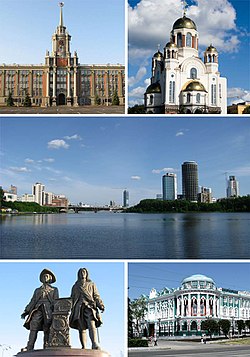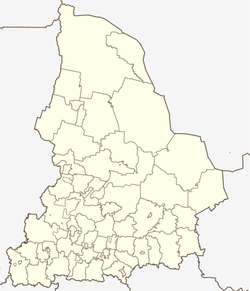Yekaterinburg
| Yekaterinburg (English) Екатеринбург (Russian) Sverdlovsk (1924-91) |
|
|---|---|
| - City - | |
 Views of Yekaterinburg, Top left:Yekaterinburg Administration hall, Top right:Church on Blood in Honour of all Saint Resplendent in the Russian land, Center:Iset River and Visotsky business area, Bottom left:A monument of Tatischev and de Gennin, Bottom right:Sevastyanov's House |
|
 Location of Sverdlovsk Oblast in Russia |
|
|
|
|
|
|
|
|
|
|
| City Day | 3rd Saturday of August |
| Administrative status (as of 2011) | |
| Country | Russia |
| Federal subject | Sverdlovsk Oblast |
| Administratively subordinated to | City of Yekaterinburg |
| Administrative center of | Sverdlovsk Oblast, City of Yekaterinburg |
| Municipal status (as of June 2009) | |
| Urban okrug | Yekaterinburg Urban Okrug |
| Administrative center of | Yekaterinburg Urban Okrug |
| Head | Yevgeny Roizman |
| Representative body | City Duma |
| Statistics | |
| Area | 495 km2 (191 sq mi) |
| Population (2010 Census) | 1,349,772 inhabitants |
| - Rank in 2010 | 4th |
| Population (2015 est.) | 1,428,042 inhabitants |
| Density | 2,727/km2 (7,060/sq mi) |
| Time zone | YEKT (UTC+05:00) |
| Founded | November 18, 1723 |
| City status since | 1796 |
| Previous names |
Yekaterinburg (until 1924), Sverdlovsk (until 1991) |
| Postal code(s) | 620000 |
| Dialing code(s) | +7 343 |
|
|
|
| on | |
Yekaterinburg (Russian: Екатеринбу́рг; IPA: [jɪkətʲɪrʲɪnˈburk]), alternatively romanised as Ekaterinburg, is the fourth-largest city in Russia and the administrative centre of Sverdlovsk Oblast, located in the middle of the Eurasian continent, on the border of Europe and Asia. At the 2010 Census, it had a population of 1,349,772.
Yekaterinburg is the main industrial and cultural centre of the Ural Federal District. Between 1924 and 1991, the city was named Sverdlovsk (Свердло́вск) after the Communist party leader Yakov Sverdlov.
Vasily Tatishchev and Georg Wilhelm de Gennin founded Yekaterinburg in 1723 and named it after the wife of Tsar Peter the Great, Yekaterina, who later became empress regnant Catherine I. The official date of the city's foundation is November 18, 1723. It was granted town status in 1796.
The city was one of Russia's first industrial cities, prompted at the start of the eighteenth century by decrees from the Tsar requiring the development in Yekaterinburg of metal-working businesses. The city was built, with extensive use of iron, to a regular square plan with iron works and residential buildings at the centre. These were surrounded by fortified walls, so that Yekaterinburg was at the same time both a manufacturing centre and a fortress at the frontier between Europe and Asia. It therefore found itself at the heart of Russia's strategy for further development of the entire Ural region. The so-called Siberian highway became operational in 1763 and placed the city on an increasingly important transit route, which led to its development as a focus of trade and commerce between east and west, and gave rise to the description of the city as the "window on Asia". With the growth in trade and the city's administrative importance, the ironworks became less critical, and the more important buildings were increasingly built using expensive stone. Small manufacturing and trading businesses proliferated. In 1781 Russia's empress, Catherine the Great, nominated the city as the administrative centre for the wider region, which led to a further increase in the numbers of military and administrative personnel in the city.
...
Wikipedia



